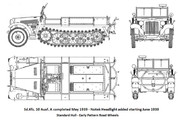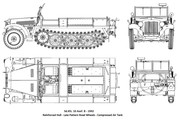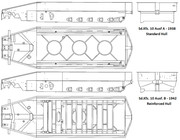What I Hope We Get For a Rubicon Sd.Kfz. 10 ModelAs this is my favorite German half track (and I realize I am likely alone in this regard), I am hoping Rubicon really do it up right. And by that I mean, provide as many options as possible, so that as many different makes and models as possible can be built.
To that end, I shall ramble on a bit about this vehicle, and interject from time to time with model options. I hope this all makes sense.
Sd.Kfz 10 Ausf A : Deliveries began in October 1938. Base vehicle had a standard chassis and standard outer road wheels (see drawing below). The windshield could fold forward, had a canvas cover (to prevent glare), and could even be removed. A convertible canvas top was mounted on the upper part of the rear body. It fastened to the windshield when erected. Four canvas side pieces could be attached to protect the crew from the weather. About 3,300 were manufactured to this initial design. Vehicles built to this standard served from the very first campaign of the war, to the very last.

Model Notes: So I hope Rubicon provides us with the parts to make this initial vehicle. As stated, over 3,300 were built to these specifications, including those that saw service during the earliest parts of the war. Needed: Standard Hull. Standard Wheels. Canvas Tilt (three possible options: up fully enclosed, up with no side panels, and down).
Major Update #1: The first pattern of road wheels had five wide-mouth cut-outs and narrow spokes. To increase the towing weight capacity, a second pattern of road wheels were introduced which had five narrow-mouth cutouts with wider, reinforced spokes. Starting in early 1940, and phased in at different times during the next 20 months by different manufacturers, these reinforced road wheels replaced standard road wheels in production. By the start of 1942 all new production used reinforced road wheels.

Model Notes: So we need a second set of road wheels. Early Pattern were used exclusively from 1938 until 1940. And then they started phasing out during 1940 and 1941. They were no longer part of new construction starting 1942. In terms of what Rubicon has shown us so far, they have shown us the reinforced road wheels. If we don't get the Early Pattern road wheels, then we cannot build any of those 3,300+ early machines. And that would be sad. To create an early war machine, and then only supply the parts to make a later model.
Major Update #2: Sd.Kfz. 10 Ausf B : Starting in April 1940 (at one manufacturer), and phased in gradually over the next 20 months by the other six manufacturers, the base model received a reinforced rear hull. This was designed to increase towing weight capacity. By the start of 1942 all new production used reinforced rear hulls.

Model Notes: The hull that is shown by Rubicon is the Ausf B hull. The main differences between the original hull and the reinforced hull are (a) the under-carriage is reinforced (which is not visible unless you overturn the model), and (b) the rear facing panel. It is my hope that Rubicon design both rear panels, so that a model maker can use the Ausf A (unreinforced hull) tail, or the Ausf B (reinforced) tail. The hull that Rubicon has shown us is the reinforced Ausf B hull.
 Extra Bits
Extra Bits : Compressed Air Tank for Air Brakes: Starting in late 1942 (September) and continuing on until the end of the war, a special version of the standard engine was produced which would compress air into a cylinder that was used to feed air brakes. The addition of air brakes allowed the Sd.Kfz. 10 to tow heavier weapons: 7.5cm PaK 40 AT gun (1.5 ton), 15cm sIG 33 infantry gun (2 ton), and the 10.5cm leFH 18 howitzer (3.5 ton). Thousands of these special engines were built between late 1942 and the end of vehicle production in late 1944. By my calculation, over half of all Ausf B models had the compressed air tank fitted.
Model Notes: I am hoping Rubicon give us the air cylinder and extra bits to mount on the rear plate. If you want to see a compressed air tank, check out the image above of the Ausf B model. A large cylinder (almost the width of the vehicle) is shown at the rear.
I am specifically targeting the base 10 model, but the above applies to the 10/4 and 10/5 as well. Those built up until 1940 used early pattern road wheels and standard hull, those built starting 1942 were built using late pattern road wheels and reinforced hull. And then we have a two-year period of 1940-1941 where the road wheels changed from early to late pattern, and the hull changed from standard to reinforced. This phased in at different times during this two years. There were seven manufacturers and they all phased in at different times.
Final Note: I love seeing the canvas tilt provided (both up and down versions). If Rubicon don't wish to provide separate rear plates to support standard versus reinforced hulls, I understand. But I REALLY hope they provide both sets of road wheels. I would like to have a proper model for Poland 1939 and France 1940.
From what I have gathered, total production was 13,988 across all types. My best analysis of the production figures know, and best guess at the production figures that didn't survive the war, leads me to the following:
SdKfz 10 Ausf A = 3,300 (from 1938 - 1941)
SdKfz 10 Ausf B = 3,637 (from 1940 - 1944)
SdKfz 10/1, 10/2 and 10/3 = 537 (from 1939 - 1941)
SdKfz 10/4 = 3,234 (from 1939 - 1942) Some of these were on Ausf A hulls, and some of these were on Ausf B hulls
SdKfz 10/5 = 3,280 (from 1942 - 1944) All of these were on Ausf B hulls